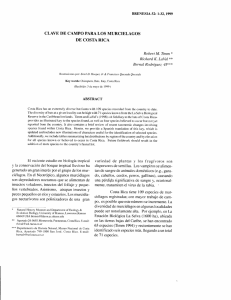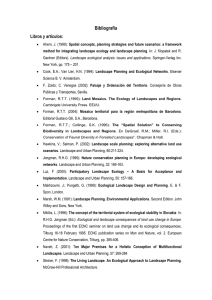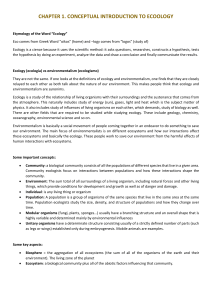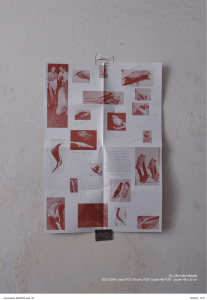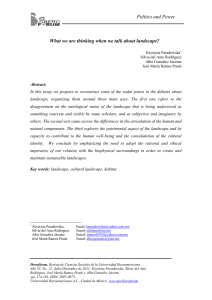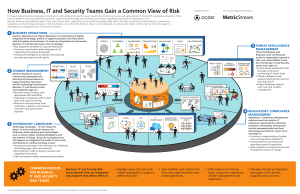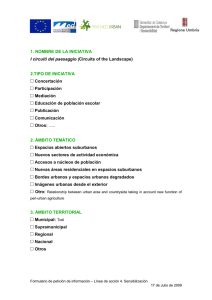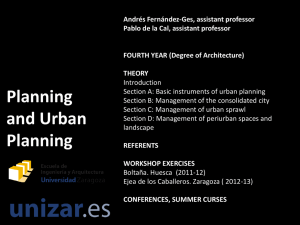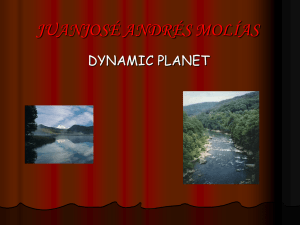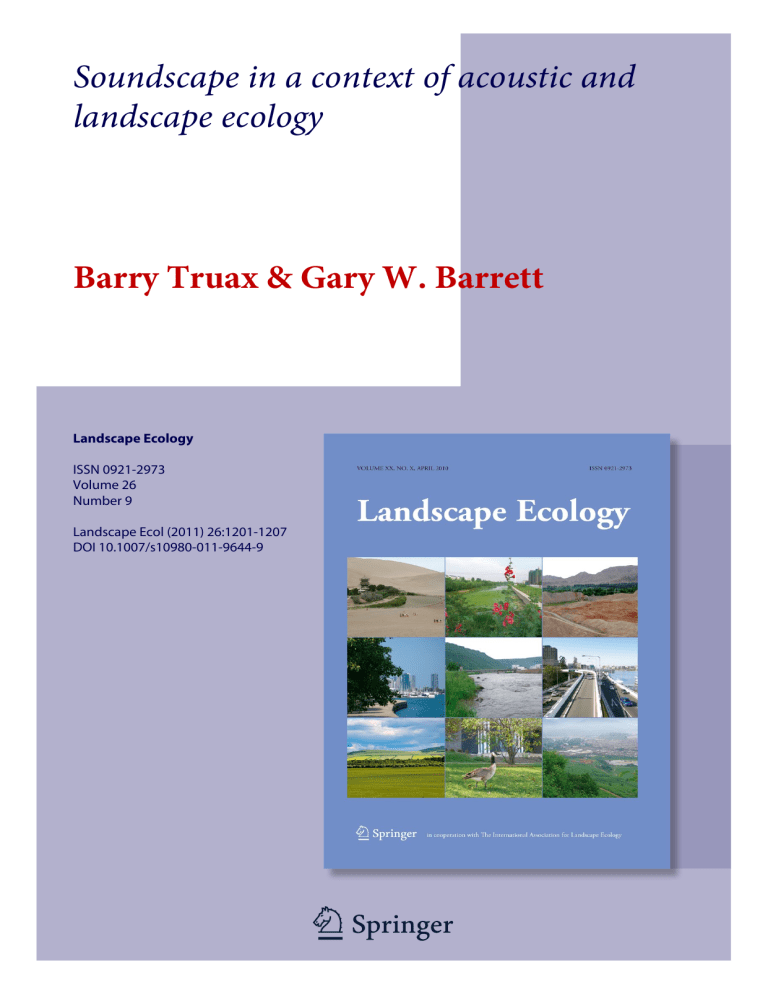
!"#$%&'()*+,$+(+'"$-*.-+"/+('"#&-,'+($%
0($%&'()*+*'"0"12
!"##$%&#'"(%)%*"#$%+,-!"##.//
!"#$%&"'()*&+,+-.
!
"##$!%&'()'&*+
,-./01!'2
$/0314!&
!
56789:6;1!<:-.!='%((>!'2?('%()('%*
@A"!(%B(%%*C9(%&D%)%(()&2EE)&
1 23
Your article is protected by copyright and
all rights are held exclusively by Springer
Science+Business Media B.V.. This e-offprint
is for personal use only and shall not be selfarchived in electronic repositories. If you
wish to self-archive your work, please use the
accepted author’s version for posting to your
own website or your institution’s repository.
You may further deposit the accepted author’s
version on a funder’s repository at a funder’s
request, provided it is not made publicly
available until 12 months after publication.
1 23
Author's personal copy
Landscape Ecol (2011) 26:1201–1207
DOI 10.1007/s10980-011-9644-9
PREFACE
Soundscape in a context of acoustic and landscape ecology
Barry Truax • Gary W. Barrett
Received: 13 July 2011 / Accepted: 10 August 2011 / Published online: 17 September 2011
! Springer Science+Business Media B.V. 2011
Abstract Soundscape ecology is being proposed as
a new synthesis that leverages two important fields of
study: landscape ecology and acoustic ecology. These
fields have had a rich history. Running ‘‘in parallel’’
for over three decades now, soundscape ecology has
the potential to unite these two (among other) fields in
ways that provide new perspectives on the acoustics of
landscapes. Each of us was involved in the ‘‘birth’’ of
these two fields. We each reflect here on the rich
history of landscape ecology and acoustic ecology and
provide some thoughts on the future of soundscape
ecology as a new perspective.
Keywords Soundscape ecology ! Acoustic ecology !
Soundscape studies ! Acoustic community
Introduction
The term ‘‘landscape ecology,’’ was first used by
Carl Troll in 1939 (Troll 1939). Landscape ecology, as
an evolving field of study, has a multidisciplinary
background based on contributions from disciplines
B. Truax (&)
Simon Fraser University, Vancouver, BC, Canada
e-mail: [email protected]
G. W. Barrett
Eugene P. Odum School of Ecology, University of
Georgiam, Athens, GA, USA
such as agronomy, architecture, economics, engineering, geography, vegetation science, and natural history
(see Naveh 1982; Naveh and Lieberman 1984; Turner
1989; Zonneveld 1990 for an early history of landscape ecology).
Landscape ecology had its roots in Europe (see
Schreiber 1990 for an early history of landscape
ecology in Europe). Troll (1966) indicated that
landscape ecology was not a new science, rather a
special viewpoint for understanding complex natural
phenomena. However, Zonneveld (1988) argued that
landscape ecology is a science, rather than a mix of
social activities, a state of mind, or human attitude.
One of the oldest meanings of landscape, especially in
fields such as landscape architecture and landscape
planning, clearly contains an esthetic element (Zonneveld 1990). More recently, Barrett et al. (2009a, b)
positions the aesthetic landscape as economy.
Other early perspectives of landscape ecology
include the chorological aspect (a conglomerate of
land units used for mapping patterns of land), landscape as an ecosystem, and the total human ecosystem
(Naveh 1982; Zonneveld 1990). Because the study of
land requires many disciplines (see above), Naveh and
Lieberman (1984) noted it was paramount to recognize landscape ecology as a ‘‘transdisciplinary’’
science.
With the encompassment of numerous disciplines
by landscape ecology, and with rapid development of
approaches in Europe, the science of landscape
ecology generated considerable interest in North
123
Author's personal copy
1202
America, especially in the United States. An increase
in American attendance in European meetings contributed to the establishment of the International
Association for Landscape Ecology (IALE) in 1982
(see Forman 1990 regarding the early history of
IALE).
Landscape ecology had its beginning in North
America during the 1980s, when Gary W. Barrett, then
ecology program director with the National Science
Foundation (NSF), recommended funding a grant
proposal, submitted by Paul G. Riser, James R. Karr,
and Richard T. T. Forman, for a workshop, ‘‘Landscape Ecology: Directions and Approaches.’’ held at
Allerton Park, Piatt County, Illinois, 25–27 April 1983
(see Risser et al. 1984, for details). This workshop was
the catalyst for the establishment of the United States
Regional Association of the International Association
for Landscape Ecology (USIALE). The first meeting
of USIALE, ‘‘The Role of Landscape Heterogeneity in
the Spread of Disturbance,’’ was held at the University
of Georgia, 15–17 January 1986 organized by Frank B.
Golley and Monica G. Turner (Turner 1987). USIALE
returned to the University of Georgia, 5–9 April 2010,
for the celebratory twenty-fifth anniversary symposium, ‘‘Is What Humans Do Natural?’’ with Gary W.
Barrett and Terry L. Barrett serving as co-program
chairs and hosts.
Special symposia, organized by Bryan C. Pijanowski, were presented at the twenty-fourth annual
(‘‘Soundscape Ecology: Merging Bioacoustics and
Landscapes’’ [with Almo Farina]) and twenty-fifth
anniversary (‘‘Soundscape Ecology: The Complexity
of Acoustical Patterns in Landscapes’’) symposia of
USIALE; the former held in Snowbird, Utah. The
symposia generated interest in soundscape ecology
with resulting publications in BioScience (Pijanowski
et al. 2011b) and subsequent articles encompassed in
this Special Issue of Landscape Ecology, co-edited by
Bryan C. Pijanowski and Almo Farina.
Currently, wherein the evolutionary process is the
science of sound in the landscape? Ecology associated
with biology until the 1970s (Odum 1977; Barrett
2001); ecology as a discipline was complemented with
numerous emerging fields of study in the 1980s (e.g.,
agroecosystem ecology, conservation biology, restoration ecology, or landscape ecology; see Barrett 1989
for listing of emerging paradigms). Landscape ecology as a transdisciplinary science has evolved into an
established and a dynamic network of integrative
123
Landscape Ecol (2011) 26:1201–1207
science, landscape aesthetics, and sustainability science for example. Soundscape ecology offers yet
another emerging field of study implicit within this
network.
The World Soundscape Project (WSP): a novel
impetus for soundscape ecology
During recent times, a number of interdisciplinary
studies have emerged involving sound. Exemplary are
studies in anthropology (Howes 2003, 2005), architecture (Blesser and Salter 2007), cultural studies (Bull
2000; Bull and Back 2003; Erlmann 2004), science
and technology (Sterne 2003; Thompson 2004; Bijsterveld 2008), and sensory history (Corbin 1998;
Smith 1999). Currently, a plethora of websites is
enhancing soundscape-based perspective by reconfiguring traditional disciplinary-based avenues of scholarly communication with a synthesis of science and
technologies.
One of the strongest precedents for this interest is
found in the pioneering work of the World Soundscape
Project (WSP) that began at the start of the 1970s at
Simon Fraser University (SFU) in British Columbia,
directed by noted Canadian composer R. Murray
Schafer. He dubbed the work ‘‘soundscape studies’’
(Schafer 1969, 1977) in an effort to find a positive
alternative to the negative anti-noise approach that
dominated most previous efforts, including Book of
Noise (Schafer 1970). Drawing on aural sensibilities
and ethical conscience of the musician, he instead
proposed a listener-based approach using techniques
of ‘‘ear cleaning’’ and ‘‘soundwalks’’ to counter the
types of soundscapes that produced a non-listening
habituated response to the acoustic environment. His
landmark book, The Tuning of the World (Schafer
1977), was the culmination of his humanities-based
approach and prescriptions for acoustic design.
In other words, the WSP approach framed soundscape studies in a subjective, listener-centered basis,
both theoretically and strategically. Examples of
perceptually based categories defined by the WSP
are sounds that are placed in the foreground or
background of one’s perception (sound signals and
keynote sounds, respectively) or regarded by the
community as culturally significant (soundmarks).
The WSP Handbook For Acoustic Ecology (Truax
1999a) defines the term ‘‘soundscape’’ as ‘‘An
Author's personal copy
Landscape Ecol (2011) 26:1201–1207
environment of sound (or sonic environment) with
emphasis on the way it is perceived and understood by
the individual, or by a society.’’ As of this writing
(2011), the International Standards Organization (as
ISO Working Group 54) is in the process of rigorously
defining the term and proposing standards for evaluation strictly on the perception and interpretation of an
acoustic environment. Given the casual application of
‘‘soundscape’’ in a variety of contexts this initiative is
welcome. However, a more inclusive redefinition of
‘‘soundscape’’ will challenge the dominant field of
acoustics and acoustical engineering, which has
traditionally treated sound objectively as a quantifiable entity, including measurements of the effects of
noise.
An original member of the WSP team, Barry Truax,
extended the subjective concept of soundscape during
the 1980s to what he termed a communicational,
information-based model. In his book Acoustic Communication (Truax 2001), he attempted to integrate the
objective approach of acoustics and subjective
approach of soundscape studies. In this model, sound
results in meaning based on two types of information
and knowledge provided by the listener: (a) information gleaned from the properties of the sound itself—
such as its spectral and temporal patterns, and
(b) listener’s knowledge of the environmental, social
and cultural context. Furthermore, the listening process can occur at different levels of attention, ranging
from a foreground, more analytical level, through to a
background, distracted or habitual level. At a macro
scale, sound is not merely energy and information
exchange, but is capable of mediating (and even
symbolizing) relationships between listeners and their
environments, reflecting a dynamic system of behaviors characteristic of an ecological approach. This
approach is readily adaptable to the introduction of the
electroacoustic mediation of aural experience that has
increasingly characterized the last century, where
patterns of sound and listening become more standardized and subject to economic constraints.
In 1993, a conference was held at Banff, Alberta, to
mark the sixtieth birthday of R. Murray Schafer, and
suitably titled ‘‘The Tuning of the World.’’ The
conference attracted several hundred participants from
around the globe, representing a variety of backgrounds and interests familiar to Schafer’s seminal
book. Prior to the conference, Hildegard Westerkamp
1203
edited the Soundscape Newsletter, as a communication vehicle for those interested in soundscape studies
and practice. By the closing of the conference, the
participants created an international initiative dubbed
the World Forum For Acoustic Ecology (WFAE). The
WFAE has since defined itself as a loose confederation
of national organizations incorporating local chapters.
Besides sponsoring local and national initiatives, the
WFAE maintains a large website (www.wfae.net);
listserv (acoustic-ecology); Soundscape Journal, edited by a rotating set of national groups; and occasional
conferences. Even a cursory glance at the work of a
group, often described as ‘‘ear-minded people,’’
reveals a profound interdisciplinary constituency and
interests.
Issues arising from soundscape ecology concepts
The excellent overview article by Guest Co-editors
Bryan C. Pijanowski et al. (2011a) in this Special
Issue, articulates several key concepts related to
Soundscape Ecology, such as acoustic composition,
temporal dynamics, spatial variability and acoustic
interactions. Each of these presents particular challenges for future research. For instance, if we look at
the spectral aspects of acoustic composition, such as
what is commonly referred to as the Acoustic Niche
Hypothesis (ANH), proposed by the bioacoustician
Krause (1987), several issues arise when we define the
soundscape in perceptual terms, as opposed to an
objective entity. The first is simply a reminder that the
human auditory system simultaneously uses both
spectral and temporal analysis, and has powerful
strategies for each in order to achieve rapid recognition of sound sources, particularly when heard in
combination. These analytical strategies are not
mutually independent but are complementary processes apparently designed to increase recognition
efficiency. In some contexts such as speech, spectral
recognition may be more efficient for certain elements
(e.g. vowels) whereas temporal recognition may do so
for others (e.g. consonants). Within spectral analysis
itself, very short temporal thresholds can be found for
sounds with periodicity (i.e. pitch, with extremely fine
resolution [a few Hertz]), and longer thresholds for
spectrum and timbre recognition, with a much broader
resolution known as the critical bandwidth, which is
123
Author's personal copy
1204
typically a little less than a quarter of an octave (Plack
2005).
A subtler issue arises when we consider the ANH
across human and nonhuman soundscapes and species.
Most is known about human auditory perception
where the perceived spectrum can be parsed into about
32 critical bands that are more or less evenly spaced on
a logarithmic scale. In passing it should be noted that
most of the readily available spectral analyzers based
on the FFT technique display their output on a linear
frequency scale, hence producing a poor representation of human perception (see Villanueva-Rivera et al.
2011). One example of a real-time logarithmic spectral display is that produced by the Spectrafoo
software. According to the ANH, when sound energy
occupies non-overlapping (critical) bands, less masking will occur than, for instance, when broadband
sounds dominate the soundscape (typical in industrialized soundscapes). Krause and the WSP discovered
positive instances of the ANH in natural, bioacoustical
soundscapes and the latter attempted to extend this
model to human, social soundscapes (see also Krause
et al. 2011). However, the ability of the auditory
system to perform this analysis (in humans within the
two and half spirals of the cochlea) is not uniform
across species, with a less developed cochlea emerging only in birds and higher on the evolutionary ladder.
Despite this difficulty, the concept of an ‘‘acoustic
habitat,’’ not merely a biological one, is a valuable
contribution to ecology.
Perception across a number of time scales is
inherent to understanding acoustic communication.
Reference already has been made to its role at the
lower, so-called ‘‘micro’’, time scale where it interacts
with spectral recognition. Mid-level, or ‘‘meso’’ time
scale recognition of pattern is clearly key to all forms
of rhythmic perception and auditory stream groupings.
Longer time scales, the ‘‘macro’’ level, interact with
the role of structure in acoustic communication
(clearly with music) and ultimately with our sense of
the human life cycle. Beyond these are evolutionary,
geological, and astronomical time scales that humans
have more difficulty understanding, at least experientially. Sound recordings have given us the means to
document sounds and soundscapes longitudinally, and
to re-experience them, as long as we have the playback
equipment to do so (not a trivial constraint). The WSP
first documented its home city of Vancouver in the
early 1970s, which resulted in the first extended
123
Landscape Ecol (2011) 26:1201–1207
analysis and representation of a city soundscape,
namely The Vancouver Soundscape (WSP 1973). A
second set of recordings in the 1990s, many at the
same locations, allowed a double CD to be produced in
1996 with tracks and compositions from both eras. In
2010, a third set of digital recordings of the Vancouver
soundscape was begun, thereby creating a 40-year
span of documentation.
In 1975, the WSP studied five villages in Europe in
five different countries (Germany, Italy, France,
Scotland, and Sweden) and published the results as
Five Village Soundscapes (WSP 1977). The key
concept that emerged from this study was that of the
‘‘acoustic community,’’ a soundscape as ‘‘acoustic
information plays a pervasive role in the lives of the
inhabitants (no matter how the commonality of such
people is understood)’’ (Truax 2001). Although a
study of small villages, the same concept was regarded
as applicable to smaller units such as a home or a
neighborhood, or even to electroacoustically defined
‘‘communities’’. The study developed criteria such as
variety, complexity and balance to describe a positively functioning acoustic community. Among these
original five villages, many differences were observed
as to how this acoustic functioning was realized, as
well as differing degrees of modernization and technological impact. In the early 2000s a group of Finnish
researchers revisited all five villages and added a sixth
Finnish one, and documented the changes that had
occurred over the intervening 25 years, publishing
their results as Acoustic Environment In Change
(Järviluoma et al. 2009). This project provides fascinating insight into longitudinal changes of dynamic
soundscapes.
In addition to spectral and temporal aspects of
soundscape perception, spatial deployment and recognition clearly play an important role. However, we
recognize that there is a danger in applying customary
visual notions of space and ability to document it in
mappings, to the experience of ‘‘acoustic space’’ that
operates on a much different set of principles. The
most dramatic difference is that acoustic space is
evanescent and unstable because it depends on time.
For anything to sound, there must be movement, and
that movement, if it produces audible sound, interacts
with the physical space and is perceived as sound that
is inextricably combined with spatial information. A
blind person might describe it as, if nothing happens
aurally, space disappears. It might be more accurate to
Author's personal copy
Landscape Ecol (2011) 26:1201–1207
suggest that sound creates acoustic space, as well as
our sense of time, rather than space and time being
‘‘containers’’ for sound. Or as Tim Ingold suggests, we
do not hear sound, we hear ‘‘in sound’’ (Ingold 2007).
The human auditory system has a remarkable
ability to separate simultaneous combined vibrations
into the perception of separate auditory streams
(Bregman 1990). The effects of spatial coloration of
sounds assist in that process, at least with balanced
soundscapes (in other words, the Acoustic Niche
Hypothesis (ANH) is not only a spectral space but also
an acoustic representation of physical space). The
most common example is called ‘‘cocktail party
effect,’’ which describes the ability of the healthy
auditory system to focus on one (correlated) source
vibration in the presence of others (an ability that
drops off rapidly with hearing impairment). Likewise
the auditory system can distinguish between the
correlated early-arriving vibrations from the laterarriving uncorrelated ones created by reflections in the
environment (though the latter can overpower the
former when precedence effect breaks down) (Truax
1999b). Hence at the primary level of psychoacoustic
perception, feature extraction of sound sources is a
complex set of abilities involving spectral and temporal cues imbedded in spatial information, all of
which, interpreted by the contextual knowledge and
ability of the listener to interact with the world, allows
the listener to form an embodied relationship with that
world.
As stated in the previous sentence, soundscape
perception is complemented by soundscape interaction—listening is intertwined with soundmaking. Just
as we cannot speak clearly without hearing ourselves
through auditory feedback, so too, our movements and
actions, along with the sounds they produce, are part of
what creates our relationship to the landscape and the
soundscape. A simple example is the soundwalk that
emphasizes listening, but also the dynamics of bodily
movement through a space. Given this system of
interaction as the basis of Soundscape Ecology, how
do we integrate disembodied electroacoustic sound
into the process of communication? Sounds are now
detached from original sources (and reattached to
loudspeakers). Recorded sounds come from an ambiguous past, amplified sounds have an arbitrarily large
(or small) volume, synthesized sounds can have no
1205
apparent physical source, and all can be packaged in
arbitrary combinations.
While the introduction of such audio elements into
the soundscape has a clear potential for disruption and
sound pollution, as well as reflecting powerful
economic interests beyond our control, more positive
aspects can also be identified with respect to Soundscape Ecology. For instance, the electroacoustic
community need not be physically bounded and can
create mass or niche communities (and markets).
Listeners fairly readily learn to decode contradictory
elements of the soundscape (elements that are ‘‘in’’ but
not ‘‘of’’ the landscape), and hence can hone new
interpretative skills. Despite having electroacoustic
sound frequently imposed on oneself, one can also
learn to regain control by embedding one sonic
environment within another, whether through portable
personal stereos or other media (Bull 2000).
Lastly, among the many creative options in the use
of audio technology, the one that may contribute most
to Soundscape Ecology is the soundscape composition
(Truax 1996, 2002, 2008). In North America it grew
out of the work of the WSP that originally used
soundscape recordings in a documentary, or ‘‘phonographic’’ mode. Early examples from Europe include
the work of Luc Ferrari and that of various radiophonic
sound artists and composers. Today the genre covers a
wide range of approaches from phonographic to
abstracted, assisted most spectacularly by multichannel reproduction that is speakers are deployed around
the audience on one or more vertical levels to create an
immersive sonic experience. Source recordings can be
stereo or multi-miked. David Monacchi has supplemented his Amazon soundscape recordings with wallsized projections of their spectrograms using Spectrafoo in a clear demonstration of the ANH. The intent
is usually some combination of pedagogic and artistic,
and the possible formats include concert, sound
installation and digital media. Given the environmental issues that are of concern to global citizens as never
before, and that all such compositions put a priority on
listener recognition of the sounds used, these works
have the ability to engage audiences with environmental representation at many levels. They can evoke
soundscape experiences in the real world as well as
transport the listener to imaginary worlds of potent
symbolism.
123
Author's personal copy
1206
Concluding remarks
Soundscape ecology is an emerging paradigm in the
field of landscape ecology. Soundscape ecology as an
emerging transdiscipline is challenged to resolve that:
(a) soundscape boundaries be established delineating
ecological systems and landscape elements in order to
quantify such parameters as biotic diversity, species
competition, and mutualistic behavior based on
sounds within changing environments (Hansen and
DiCastri 1992); (b) science of sound in the landscape
contribute to problem-solving approaches focused on
ecological resource management (Barrett 1985), and
as an emerging component of sustainability science
(Wu 2008; Barrett et al. 2009a); (c) funding be
provided (private and public) to analyze and integrate
the collection of sounds across temporal-spatial scales
to configure ecosystem/landscape patterns and processes; and (d) contextualize sound as acoustic process
within a transdisciplinary science of soundscape
ecology.
Acknowledgments We thank Co-editors Bryan C. Pijanowski
and Almo Farina for their invitation to contribute to this Special
Issue of Landscape Ecology; and Editor-In-Chief Jianguo Wu
for insightful recognition and publication of an emerging field of
knowledge, education, research, and service.
References
Barrett GW (1985) A problem-solving approach to resource
management. Bioscience 35:423–427
Barrett GW (1989) Viewpoint: a sustainable society. Bioscience
39:754
Barrett GW (2001) Closing the ecological cycle: the emergence
of integrative science. Ecosyst Health 7:79–84
Barrett TL, Farina A, Barrett GW (2009a) Positioning aesthetic
landscape as economy. Landscape Ecol 24(3):299–307
Barrett TL, Farina A, Barrett GW (2009b) Aesthetic landscapes:
an emergent component in sustaining societies. Landscape
Ecol 24(8):1029–1035
Bijsterveld K (2008) Mechanical sound: technology, culture,
and public problems of noise in the twentieth century. MIT
Press, Cambridge, MA
Blesser B, Salter LR (2007) Spaces speak, are you listening?
Experiencing aural architecture. MIT Press, Cambridge,
MA
Bregman A (1990) Auditory scene analysis. MIT Press,
Cambridge, MA
Bull M (2000) Sounding out the city: personal stereos and the
management of everyday life. Berg, Oxford
Bull M, Back L (eds) (2003) The auditory culture reader. Berg,
Oxford
123
Landscape Ecol (2011) 26:1201–1207
Corbin A (1998) Village bells: sound and meaning in the
nineteenth-century French countryside. Columbia
University Press, New York
Erlmann V (ed) (2004) Hearing cultures: essays on sound,
listening and modernity. Berg, Oxford
Forman RTT (1990) Beginnings of landscape ecology in
America. In: Zonneveld IS, Forman RTT (eds) Changing
landscapes: an ecological perspective. Springer-Verlag,
New York, pp 21–33
Hansen AJ, DiCastri F (1992) Landscape Boundaries: consequences for biotic diversity and ecological flows. SpringerVerlag, New York
Howes D (2003) Sensual relations: engaging the senses in
culture and social theory. University of Michigan Press,
Ann Arbor, MI
Howes D (2005) Empire of the senses: the sensual culture
reader. Berg, Oxford, NY
Ingold T (2007) Against soundscape. In: Carlyle A (ed) Autumn
leaves. Double Entendre, Paris, pp 10–13
Järviluoma H, Kytö M, Truax B, Uimonen H, Vikman N (eds)
(2009) Acoustic environments in change. University of
Tampere, Tampere
Krause B (1987) Bioacoustics: habitat ambience in ecological
balance. Whole Earth Rev 57:14–18
Krause B, Gage SH, Joo W (2011) Measuring and interpreting
the temporal variability in the soundscape at four places in
Sequoia National Park. Landscape Ecol. doi:10.1007/
s10980-011-9639-6
Naveh Z (1982) Landscape ecology as an emerging branch of
human ecosystem science. Adv Ecol Res 12:189–237
Naveh Z, Lieberman AS (1984) Landscape ecology: theory and
application. Springer-Verlag, New York
Odum EP (1977) The emergence of ecology as a new integrative
discipline. Science 195:1289–1293
Pijanowski BC, Farina A, Gage SH, Dumyahn SL (2011a) What
is soundscape ecology? Landscape Ecol. doi:10.1007/
s10980-011-9600-8
Pijanowski BC, Villanueva-Rivera LJ, Dumyahn SL, Farina A,
Krause BR, Napoletano BM, Gage SH, Pieretti N (2011b)
Soundscape ecology: the science of sound in landscapes.
Bioscience 61:203–216
Plack C (2005) The sense of hearing. Lawrence Erlbaum,
Mahwah, NJ
Risser PG, Karr JR, Forman RTT (1984) Landscape ecology:
directions and approaches. Natural History Survey Number
2, Champaign, IL
Schafer RM (1969) The new soundscape. Universal Edition,
Vienna
Schafer RM (1970) The book of noise. Price, Milburn,
Wellington. Reprinted 1998. Arcana Editions, Indian
River, ON
Schafer RM (1977) The tuning of the world. Knopf, New York.
Reprinted 1994 as Our sonic environment and the
soundscape: the tuning of the world. Destiny Books,
Rochester, VT
Schreiber KF (1990) The history of landscape ecology in Europe. In: Zonneveld IS, Forman RTT (eds) Changing
landscape: an ecological perspective. Springer-Verlag,
New York, pp 21–33
Smith B (1999) The acoustic world of early modern England.
University of Chicago Press, Chicago, IL
Author's personal copy
Landscape Ecol (2011) 26:1201–1207
Sterne J (2003) The audible past: cultural origins of sound
reproduction. Duke University Press, Durham, NC
Thompson E (2004) The soundscape of modernity: architectural
acoustics and the culture of listening in America,
1900–1933. MIT Press, Cambridge, MA
Troll C (1939) Luftbildplan and okologische Bodenforschung.
Z. Ges. Erdkunde, Berlin, pp 241–298
Troll C (1966) Landscape ecology. Publication S 4 ITC-UNESCO, Delft
Truax B (1996) Soundscape: acoustic communication and
environmental sound composition. Contemp Music Rev
15:49–65
Truax B (1999a) Handbook for acoustic ecology. Cambridge
Street Publishing, Vancouver, BC
Truax B (1999b) Composition and diffusion: space in sound in
space. Organ Sound 3:141–146
Truax B (2001) Acoustic communication, 2nd edn. Ablex
Publishing, Westport, CT
Truax B (2002) Genres and techniques of soundscape composition as developed at Simon Fraser University. Organ
Sound 7:5–14
Truax B (2008) Soundscape composition as global music:
electroacoustic music as soundscape. Organ Sound 13:
103–109
Turner MG (1987) Landscape heterogeneity and disturbance.
Springer-Verlag, New York
Turner MG (1989) Landscape ecology: the effects of pattern on
progress. Annu Rev Ecol Syst 20:171–197
1207
Villanueva-Rivera LR, Pijanowski BC, Doucette J, Pekin B
(2011) Sounds 101: an introduction to acoustics for landscape ecologists with tutorials. Special Edition. Landscape
Ecol. doi:10.1007/s10980-011-9636-9
World Soundscape Project. The Music of the Environment
Series. Schafer RM (ed) ARC Publications, Vancouver,
BC: No. 1, The Music of the Environment, 1973. No. 2,
The Vancouver Soundscape, 1978; CD re-issue (with
Soundscape Vancouver, Cambridge Street Publishing,
1996). No. 3, European Sound Diary, 1977. No. 4, Five
Village Soundscapes, 1977; reprinted in Acoustic Environments in Change, H. Järviluoma et al. (eds) University
of Tampere, 2009. No. 5, Handbook for Acoustic Ecology,
1978; reprinted as a CD-ROM, Cambridge Street Publishing, 1999
Wu J (2008) Making the case for landscape ecology: an effective
approach to urban sustainability. Landscape J 27:41–50
Zonneveld IS (1988) Landscape ecology and its application. In:
Moss M (ed) Landscape ecology and management. Polyscience Public, Montreal, QC, pp 3–15
Zonneveld IS (1990) Scope and concepts of landscape ecology
as an emerging science. In: Zonneveld IS, Forman RTT
(eds) Changing landscape: an ecological perspective.
Springer-Verlag, New York, pp 3–20
www.wfae.net. Accessed 19 Aug 2011
123
